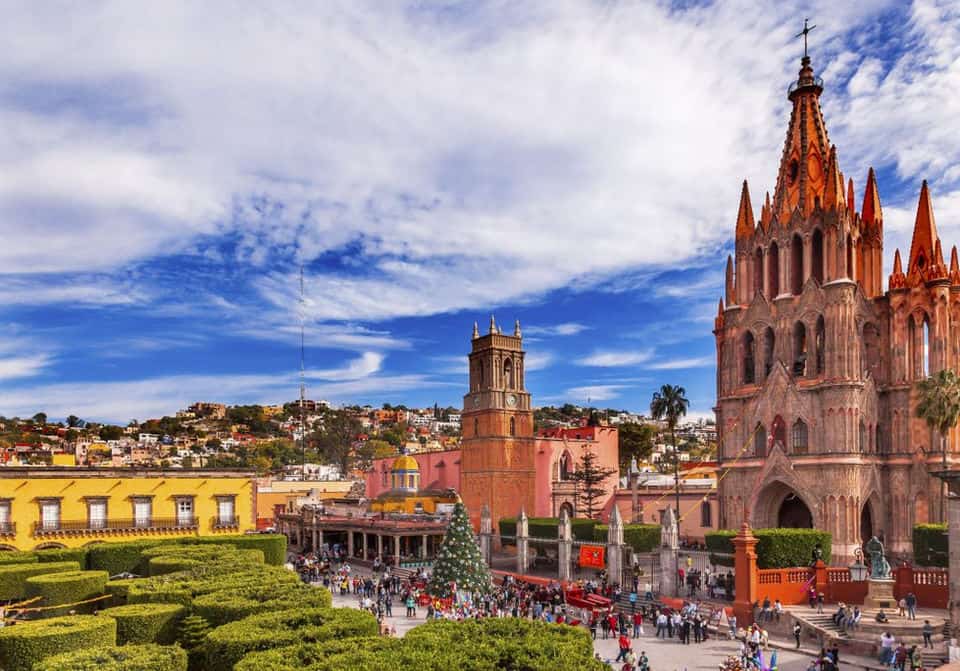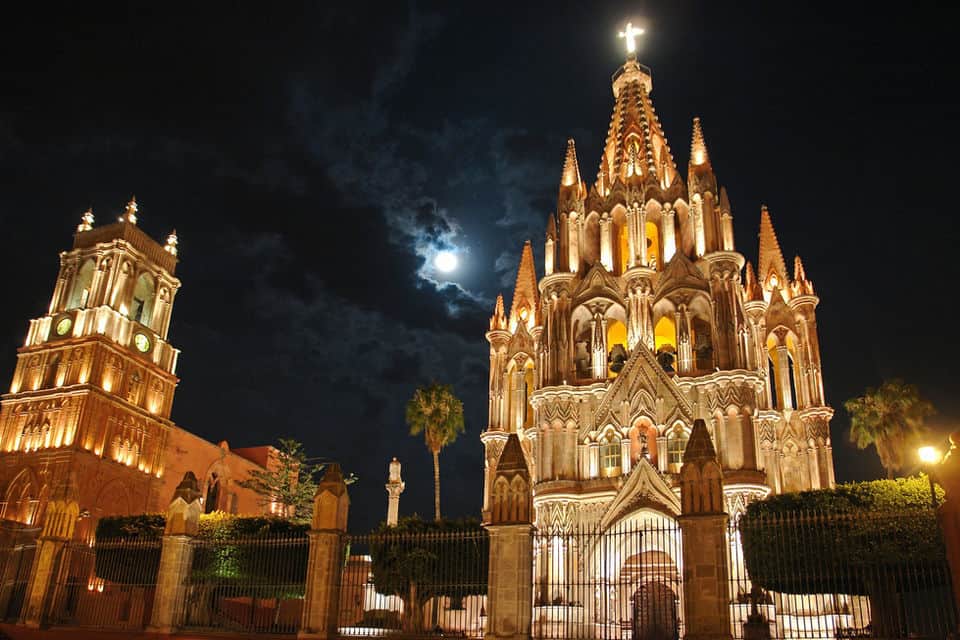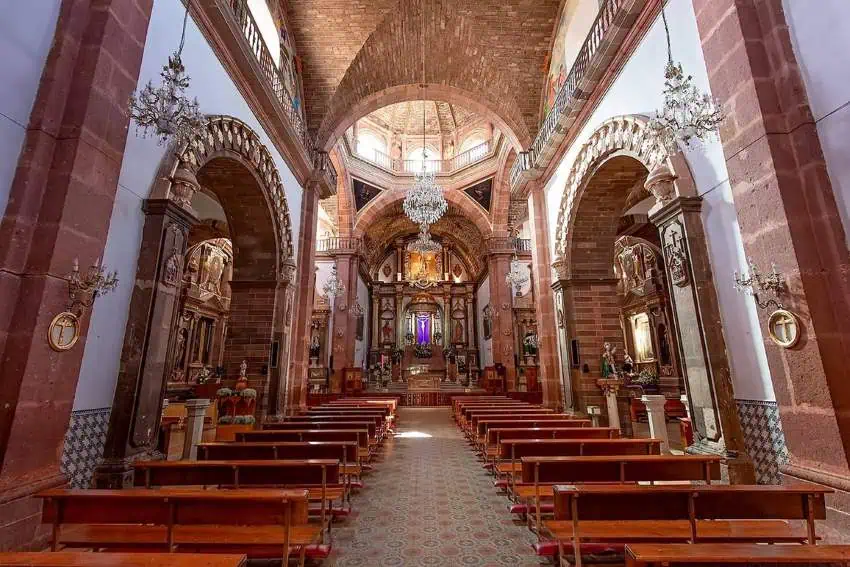From nearly anywhere in the Guanajuato city of San Miguel de Allende, your eyes will be drawn to the Parroquia de San Miguel Arcángel, known colloquially as simply La Parroquia.
Glowing in sunlight by day and artfully lit at night, the Parroquia towers over the city as its most iconic landmark. With its pink spires and Gothic-inspired silhouette, the building is impossible to ignore and equally hard to classify. Its architectural style defies easy labels because the church wasn’t built in a single era. It has been reinforced, expanded and reimagined over centuries.

A modest start for a growing village
The first parish church in San Miguel was built shortly after the town was founded in 1542 by Franciscan friars. It was a simple structure, adequate for the small settlement at the time. As the population grew, the need for a larger place of worship became clear. In 1578, the church was completely rebuilt to serve the expanding community.
Over time, the structure began to deteriorate, and by 1690, it was in such poor condition that town leaders formally petitioned the viceroy. They argued that although local tithes had been allocated in perpetuity for the building’s maintenance, the funds were likely being mismanaged by church officials.
The viceroy agreed to investigate and sent the esteemed Mexico City architect Marco Antonio Sobrarías to assess the damage. He concluded that the church was unsafe and should be closed to prevent any tragedies, recommending a complete rebuild with new foundations, a larger floor plan and added transepts to give it grandeur. In 1698, the Bishop of Valladolid officially ordered the reconstruction of the church and contributed 1,000 pesos to get things started.
Sobrarías designed the renovation in a modest Baroque style with a Latin cross layout and two side chapels, one dedicated to the Señor de la Conquista (Lord of the Conquest) and the other to the Virgen de los Dolores (Our Lady of Sorrows). He built the main nave with semicircular arches, which later made it possible to convert those areas into chapels for the Virgen del Carmen and the Virgen del Rosario.

Sobrarías worked on the project for about two years and, in 1692, reported to the viceroy that the building was nearly complete but required a few more expenses. Despite repeated requests, he never received the full annual salary of 1,460 pesos he had been promised, nor the additional funding required.
Sobrarías eventually returned to Mexico City, where he was assigned to work on the Metropolitan Cathedral and the Royal Palace. Architect Juan Antonio de Guzmán was then appointed to complete the renovation for a lower salary, bringing the project to completion in 1709.
18th-century upgrades and a 19th-century crisis
In 1740, a second tower was added to the Parroquia to provide the visual symmetry expected of a proper colonial church. This addition reflected the growing importance of San Miguel and the desire to create a more dignified place of worship.
Throughout the 18th century, the interior was gradually enriched to match this elevated exterior. Baroque altarpieces, religious paintings and ornate devotional artwork were added over time as tastes evolved and resources allowed.

However, by the late 1800s, the Parroquia was once again in crisis. The west tower had become so unstable that its bells had to be removed, and the façade had a large crack running from the choir vault at the top all the way down to the main entrance. While temporary repairs kept it standing for a while, it became clear that major intervention was necessary.
The neo-Gothic transformation
The church’s priest at that time, José María de Jesús Diez de Sollano y Dávalos, made a bold choice: he commissioned local stonemason Zeferino Gutiérrez for the restoration project. Gutiérrez had no formal architectural training but a well-earned reputation for craftsmanship and creativity.
Between 1880 and 1890, Gutiérrez led the transformation, drawing inspiration from postcards of European cathedrals. He designed a striking neo-Gothic façade complete with soaring towers, pointed arches, finials and intricate stone carvings. The stone used for the façade was pink cantera quarried from the slopes of the nearby Palo Huérfano volcano, which not only provided the distinctive color but also was located close enough to make the large-scale project feasible.
Before work on the new façade could begin, Gutiérrez focused on reinforcing the existing structure. The original side towers were removed as they had become too unstable to remain standing. He also reinforced the church’s main walls and addressed foundation issues.
Inside, the church took on a new character, with the introduction of Neoclassical elements. The original wooden altars, damaged by wear, were replaced with finely carved stone altars made of the same local cantera stone. These updates brought a sense of visual harmony between the interior and exterior and ensured that the building could support the weight of the new design.
This major restoration was extraordinary not only for what it accomplished but also for how it was done. It wasn’t only Gutiérrez’s vision; it was the people of San Miguel who made it possible. Women and children carried sacks of sand and small stones, while men hoisted boulders, loading carts and wheelbarrows to transport material from the Río Laja to the construction site.
It was, as the townspeople called it at the time, ant-like work. Working for years without pay, it was the effort of a united community driven by devotion. They were building a temple worthy of their faith.
More than a postcard-perfect church
Despite its grand appearance, the Parroquia has always been a parish church. San Miguel de Allende is not the seat of a bishop, so its main church has never been a cathedral. While it’s one of the most photographed tourist attractions in Mexico, it serves the local community as a place of worship and religious celebrations. Guests are welcome to enter, though they’re asked to limit visits during Mass, which takes place several times a day.
Its esplanade and the park across from it, known today as El Jardín, are Sanmiguelenses’ favorite gathering spot. This is where both locals and tourists enjoy street food, sing along to mariachi bands, take pictures with the larger-than-life paper mache mojigangas and attend major events.
Throughout San Miguel de Allende’s complex history, the Parroquia has always stood at the heart of it all, whimsical and deeply loved by residents both past and present.
Sandra Gancz Kahan is a Mexican writer and translator based in San Miguel de Allende who specializes in mental health and humanitarian aid. She believes in the power of language to foster compassion and understanding across cultures. She can be reached at [email protected]
